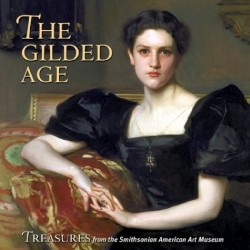The Gilded Age
Treasures from the Smithsonian American Art Museum
Though a “Closed for Renovation” sign will turn away tourists and art lovers from the Smithsonian American Art Museum’s home in the Old Patent Office Building for the next three years, its collection will not go unattended. For those who haven’t been to Washington lately, Washington will now come to a museum near them, as national treasures (many never before loaned out) are reconfigured into eight simultaneous touring exhibitions. The Gilded Age is only one of its handsome calling cards, a gilt mirror self-portrait of the tastes of its nineteenth-century industrialist patrons.
In stark contrast, for example, to the “Lure of the West,” the exhibit highlighting American artists who depicted the raw glory of the frontier, The Gilded Age’s artists hugged the eastern shore, attending to European-defined tradition. True, there is Winslow Homer’s brooding majestic High Cliff, Maine, but more common are the many expatriate artists who imbued their brushes and bronzes with Renaissance-inspired palettes and mythical motifs (the life-size marble Venus and Adonis toured America in a burlap shroud to cover its bold nakedness), or Oriental exotica (Louise Comfort Tiffany’s Market Day Outside the Walls of Tangiers). When these two artistic impulses intersect, as in John Singer Sargent’s society portrait of a lady (Elizabeth Winthrop Chanler), the result is an opulent, uneasy character study of a tense-looking woman seated in a gilded salon cage. Sophistication, even in the three decades before World War I, had its price.
Certain artists have name cachet, but others may find new audiences. Cecilia Beaux, Thomas Eakins and Albert Pinkham Ryder, whose names are more familiar, share the stage with lesser known, but deserved, artists, such as Paul Wayland Bartlett’s bronze Bohemian Bear Tamer and J. William Fosdick’s Adoration of St. Joan of Arc. In its museum quality reproductions, The Gilded Age is a refreshing walk through time, a lively, informed study of American taste in the making.
Reviewed by
Leeta Taylor
Disclosure: This article is not an endorsement, but a review. The publisher of this book provided free copies of the book to have their book reviewed by a professional reviewer. No fee was paid by the publisher for this review. Foreword Reviews only recommends books that we love. Foreword Magazine, Inc. is disclosing this in accordance with the Federal Trade Commission’s 16 CFR, Part 255.

